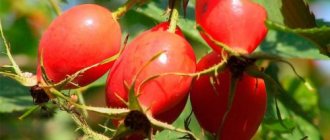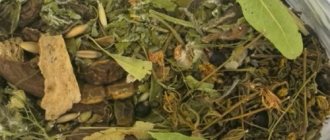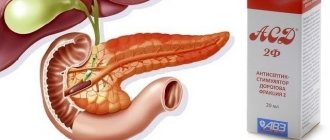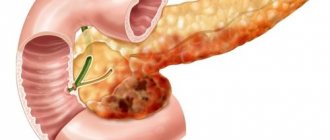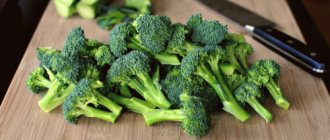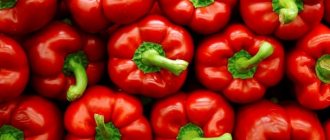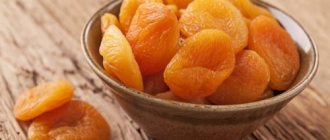Burdock (or burdock, turnip, lapushnik, grandfather) is well known to many and can be used as a choleretic and anti-inflammatory agent in herbal medicine for pancreatitis. There are many varieties of this medicinal plant, but burdock or felt burdock is most often used for treatment. In this article we will introduce you to the beneficial properties of this plant and how to use it for pancreatitis. In herbal medicine for this disease, burdock can be used either independently or as part of herbal infusions.
The composition of burdock includes:
- Essential oils;
- Polysaccharide inulin;
- Bitterness;
- Stigmasterin;
- Sitosterol;
- Vitamins B, A, C, P and E;
- Organic acids;
- Fatty acid;
- Proteins;
- Tannins;
- Resins;
- Mineral salts.
In herbal medicine, different parts of burdock are used: root, leaves and stems, inflorescences and fruits. Thanks to its rich composition, this medicinal plant is actively used to treat the digestive system, urinary system, joints, skin and hair, teeth and gums, intoxication, diabetes, mastopathy and other diseases.
How does burdock affect the body during pancreatitis?
Burdock has a powerful choleretic effect and promotes more active production of pancreatic enzymes. This effect ensures the normalization of digestion in general and can prevent exacerbation of pancreatitis, which is often caused by stagnation of bile. In addition, this plant is often used in the treatment of diseases associated with pancreatitis: gastritis, peptic ulcers, liver pathologies, colitis and diabetes.
The healing properties of burdock for pancreatitis
- Choleretic;
- Anti-inflammatory;
- Moderately analgesic;
- Antispasmodic;
- Bactericidal;
- Activating the production of pancreatic enzymes;
- Laxative;
- Carminative;
- Appetizing;
- Antidiabetic.
In addition to these beneficial properties, burdock has the following effects:
- Sweatshop;
- Antipyretic;
- Normalizing metabolism;
- Lithotripsy (crushing stones) for cholelithiasis and urolithiasis;
- Detoxification;
- Diuretic;
- Anti-carcinogenic;
- Antisclerotic;
- Antimicrobial and antiseptic;
- Antiallergic;
- Wound healing.
The healing effect of burdock
Burdock is effective in the treatment of many diseases, so it is used as an addition to the main complex of therapy. The plant normalizes the functioning of the digestive system, prevents re-development of the disease and stagnation of bile.
Due to its strong choleretic properties, burdock is used for gastritis, ulcers, and liver dysfunction. The healing plant relieves colitis and normalizes the general condition of people diagnosed with diabetes.
Burdock root has an anti-inflammatory and choleretic effect on the body for pancreatitis. This folk remedy relieves pain, spasms, and destroys harmful bacteria.
- Burdock tincture helps to activate the production of pancreatic enzyme substances.
- The natural medicine helps to loosen the stomach and improve the patient's appetite.
- Burdock root is especially useful for the pancreas in diabetes mellitus.
Where can I get burdock to treat pancreatitis?
The leaves or roots of this plant are used to treat pancreatitis. It grows everywhere: near houses, in forests, in wet wastelands, near rivers and lakes. For harvesting, you should not use those plants that grow near enterprises or highways.
The leaves are harvested during the burdock flowering period, which usually begins in June-August. And the roots of this plant should be collected only in the first year of its life, because over time its medicinal substances are spent on growth and flowering and the root becomes flabby and fibrous. Harvesting this part of the plant should occur in September-October or early spring.
The collected leaves are dried in a well-ventilated place protected from the sun until completely dry. After this, the raw materials are packaged in paper bags or wooden containers and stored in a dry and dark place for no more than 1 year.
Burdock roots are cleared of soil and washed in running water. If the root is thick, then it is cut lengthwise. Next, the raw material is cut into 10-15 cm pieces and laid out on paper or fabric. The root is dried in a well-ventilated place or on a cooled Russian oven. Dried raw materials are packaged in paper bags or wooden containers and stored for no more than 3 years.
In summer, burdock juice, used to treat pancreatitis, is prepared from the collected green leaves of the plant or fresh roots. Before preparing it, they are thoroughly washed and dried with a towel.
Treatment of pancreatitis with burdock
To eliminate signs of the disease, burdock juice is used, which serves as an excellent choleretic agent for disorders of the liver gland.
The leaves are washed, dried in a paper towel and finely chopped. The resulting porridge is squeezed through gauze. The drink is consumed 1 tbsp. three times a day before meals. The duration of treatment is one week and the same break, then the therapy is continued.
Infusions and decoctions are good remedies:
- Finely chop 5 g of roots and pour into a thermos. Pour 500 ml of hot liquid and infuse overnight. Consume three times a day before meals, 45 minutes.
- To burdock root extract in the amount of 2 tbsp. l. pour 250 ml of hot liquid. Leave for 4 hours, then put the mixture on low heat and cook for 20 minutes. The decoction is consumed before meals three times a day. Check the norm with your doctor.
How to take burdock for pancreatitis?
In acute pancreatitis or during an exacerbation, doctors do not recommend using alternative treatment methods. Taking an infusion or decoction of burdock root and leaves or juice is recommended after eliminating the acute symptoms of attacks. The beginning of the use of such drugs should be determined by the doctor, taking into account data on the patient’s condition.
Burdock juice
The juice of this plant is used as a choleretic agent and for diseases of the liver or biliary tract. You can prepare it yourself from young leaves and fresh roots or purchase it at a pharmacy, where it is sold as a concentrate.
To prepare the juice yourself, the leaves and roots are washed and dried with a towel. Such raw materials are crushed with a blender or passed through a meat grinder. The pulp is squeezed out, and the resulting juice is taken half an hour before meals, 1 teaspoon three times a day. The course of treatment is usually one week. After this, a week break is taken and the course of treatment is repeated.
The juice from burdock roots has a very bitter taste. To eliminate this unpleasant moment, you can dilute it with water or add honey to it.
Root infusion
5 g of crushed roots are placed in a thermos and 500 ml of boiling water is poured. Leave overnight. Take, divided into 3 servings, half an hour before meals three times a day.
Facts about burdock
Another name for the plant is burdock. But among the common people, burdock is known as burdock, burdock.
The medicinal plant contains many useful components. Its medicinal properties are used in the treatment of biliary dyskinesia and cholesterosis of the gallbladder walls. The juice of the leaves has a pronounced choleretic (choleretic) effect. It is for this reason that burdock is included in herbal preparations intended for the treatment of the above-mentioned diseases.
Burdock is used for pancreatitis due to its pronounced choleretic, socogonal and anti-inflammatory effect. The healing properties are more characteristic of the leaves and root system of the plant.
Root decoction
2 heaped tablespoons of raw material are poured into 250 ml of water and left for 4 hours. The dishes are placed on low heat, brought to a boil and boiled for about 15-20 minutes. The decoction is filtered and taken 50 ml half an hour before meals three times a day.
Infusion of leaves
Recipe No. 1
60 g of leaves are poured into 600 ml of boiling water and left for about 4 hours. The infusion is filtered and drunk 200 ml three times a day half an hour before meals. The infusion is used to treat peptic ulcers or crush stones in the gall bladder or kidneys.
Recipe No. 2
Pour a tablespoon of leaves into a glass of boiling water and leave for 1 hour. Strain and take 1/3 cup half an hour before meals. The infusion is used to treat diseases of the stomach, liver and intestines.
Seed decoction
A decoction of burdock seeds is used to relieve constipation, which in some cases is observed in patients with pancreatitis. To prepare it, 20 g of raw material is boiled in 200 ml of water. The broth is infused under the lid for about 20 minutes, filtered and taken 1 tablespoon 3 times a day.
Tincture of burdock roots or leaves
Many folk recipes suggest the use of tinctures from various parts of this plant. It is prepared with alcohol or vodka. Doctors do not recommend using it to treat pancreatitis, since alcohol can aggravate this and other diseases of the digestive tract.
Complex treatment with folk remedies
Many plants are effective in treating pancreatitis, so it is recommended to use all kinds of herbal remedies. To prepare a healing collection, you will need a small amount of St. John's wort, sage, horsetail, string, wormwood, burdock root, elecampane, calendula flowers, and chamomile.
All of these herbs have strong anti-inflammatory properties. The plants contain useful elements that stimulate the functioning of the pancreas, remove bile, reduce intoxication, improve digestion, and get rid of bacteria. For this reason, this collection is considered effective for pancreatitis.
The mixture is brewed using the traditional method at the rate of one tablespoon per glass of boiling water. The herbs are poured in and infused for an hour. Take the medicinal infusion three times a day, 0.5 cups.
- Immortelle effectively treats subtle pancreatitis, removes bile and gastric juice, normalizes the functioning of the digestive system, and has a disinfectant, hemostatic and astringent effect. A tablespoon of herb is poured with hot water, the mixture is boiled over low heat. The broth is cooled, filtered and taken 0.5 cup three times a day.
- Licorice, which produces the necessary enzymes and relieves swelling of the pancreas, stops the inflammatory process no less effectively. To prepare the decoction, use crushed plant roots in an amount of 5 g. They are poured with 0.5 liters of cold water and boiled.
- To enhance the healing effect, burdock and dandelion are added to the roots. The medicine is cooled, filtered and consumed within 24 hours.
Burdock and pancreatic diseases
High effectiveness can be expected if a decoction or juice of burdock is prescribed for biliary-dependent pancreatitis. In this situation, the choleretic effect is most appropriate in a combination treatment regimen.
Burdock juice is famous for its juice effect
Chronic pancreatitis is accompanied by a decrease in organ function. Pancreatic cells do not synthesize the required amount of enzymes. Burdock juice for pancreatitis stimulates their work. With prolonged use, the improvement becomes obvious.
Burdock stimulates the work of all digestive glands of various parts of the gastrointestinal tract. The use of burdock decoction or juice for atrophic gastritis, which accompanies inflammation of the pancreas in most cases, is considered justified.
Additional properties of burdock
Burdock root is useful for pancreatitis because it reduces the severity of inflammatory manifestations. Its use prevents severe exacerbations. It is also known that the plant contains compounds that have a pronounced antispasmodic effect.
One of the unpleasant manifestations of chronic pancreatitis is a tendency to constant constipation. Treatment with enzyme preparations does not always have the expected effect. Patients have to resort to laxatives. But the big problem is that they quickly become addictive, and this dictates the need to increase the dose of already unsafe drugs.
The use of burdock-based preparations helps to cope with this symptom. Feces become softer and move more easily through the intestinal tube. In addition, peristalsis increases. All this alleviates the patient’s suffering and improves the quality of life.
A decoction of burdock root or leaves has a pronounced antimicrobial property. It is used in the case of pancreatic pathology when intestinal dysbiosis occurs. We are talking about a situation when the intestinal tube is not inhabited by bacteria familiar to the body, but by pathogenic ones, causing a lot of symptoms and problems. Together with probiotics, burdock-based products eliminate dysbiosis.
